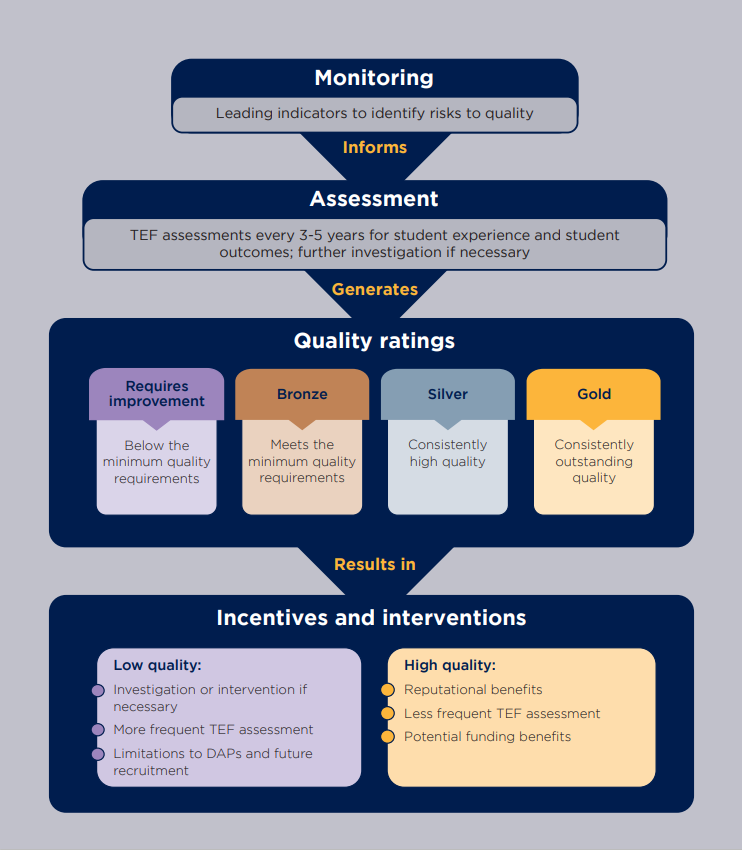Consultation on the future approach to quality regulation
Published 18 September 2025
Consultation proposals
Summary of initial proposals
Section 1: Overall quality system
Proposal 1: A more integrated overall system
We propose to modify the overall quality system to ensure that it is integrated, drives improvement across the sector, and provides a clear view of the quality delivered by different providers.
Section 2: The future TEF
Proposal 2: Providers in scope
We propose to assess and rate all OfS-registered providers through the future TEF, on a cyclical basis, with rolling assessment cycles.
Proposal 3: Provision in scope
We propose to assess undergraduate provision in the first cycle of assessments and to extend the scope to include postgraduate taught provision in the second cycle.
Proposal 4: Assessment aspects and ratings
We propose to assess and rate providers for ‘student experience’ and ‘student outcomes’, and to generate ‘overall’ provider ratings based on these two aspect ratings.
Proposal 5: The student experience aspect
We propose to:
- align the scope and ratings criteria for the student experience aspect with the requirements of conditions B1, B2 and B4
- assess the student experience on the basis of provider submissions, an expanded set of NSS-based indicators, and additional evidence from students.
Proposal 6: A revised and integrated condition B3
We propose to revise and simplify our minimum requirements for student outcomes (condition B3), and integrate into the future TEF an assessment of whether a provider meets them.
Proposal 7: The student outcomes aspect
We propose to rate student outcomes based on benchmarked indicators of continuation, completion and an expanded set of post-study indicators, and taking contextual factors into account.
Proposal 8: Assessment and decision making
We propose:
- that TEF assessments would be conducted by an evolving pool of academic and student assessors, supported and advised by OfS staff
- to adopt a risk-based approach for the assessors to give further consideration, when outcomes would have a potentially negative impact on a provider.
Proposal 9: Varying the approach for providers with limited data
We propose to:
- use an alternative means of gathering students’ views, where we do not have sufficient statistical confidence in the NSS-based indicators for a provider.
- not rate the student outcomes aspect, where we do not have sufficient statistical confidence in the student outcomes indicators for a provider.
Proposal 10: Student evidence and involvement
We propose to include direct student input in the assessment of the student experience aspect for all providers, and to expand the range of student assessors.
Proposal 11: Assessment cycle
We propose to assess each provider for the first time within three years, according to a set of priorities, and to link the timing of further assessments to the ratings awarded and our ongoing risk monitoring.
Section 3: A risk-based system of incentives and interventions
Proposal 12: Risk monitoring
We propose to introduce a risk monitoring tool that sets out the factors associated with increased risks to quality.
Proposal 13: Incentives and interventions
We propose to introduce a strengthened set of incentives and interventions that vary according to the level of quality and risk, to drive quality improvement across the sector.
Section 4: Published outputs of the overall system
Proposal 14: Published outputs
We propose to continue publishing the outputs and outcomes of our quality assessments, aimed at providing clear information to students about the level of quality delivered by different providers, and incentivising and supporting providers’ efforts to enhance quality.
Section 5: Implementation, ongoing development and evaluation
Proposal 15: Timeline
We propose to consult further during 2026-27 and carry out the first cohort of future TEF assessments in 2027-28.

Describe your experience of using this website
